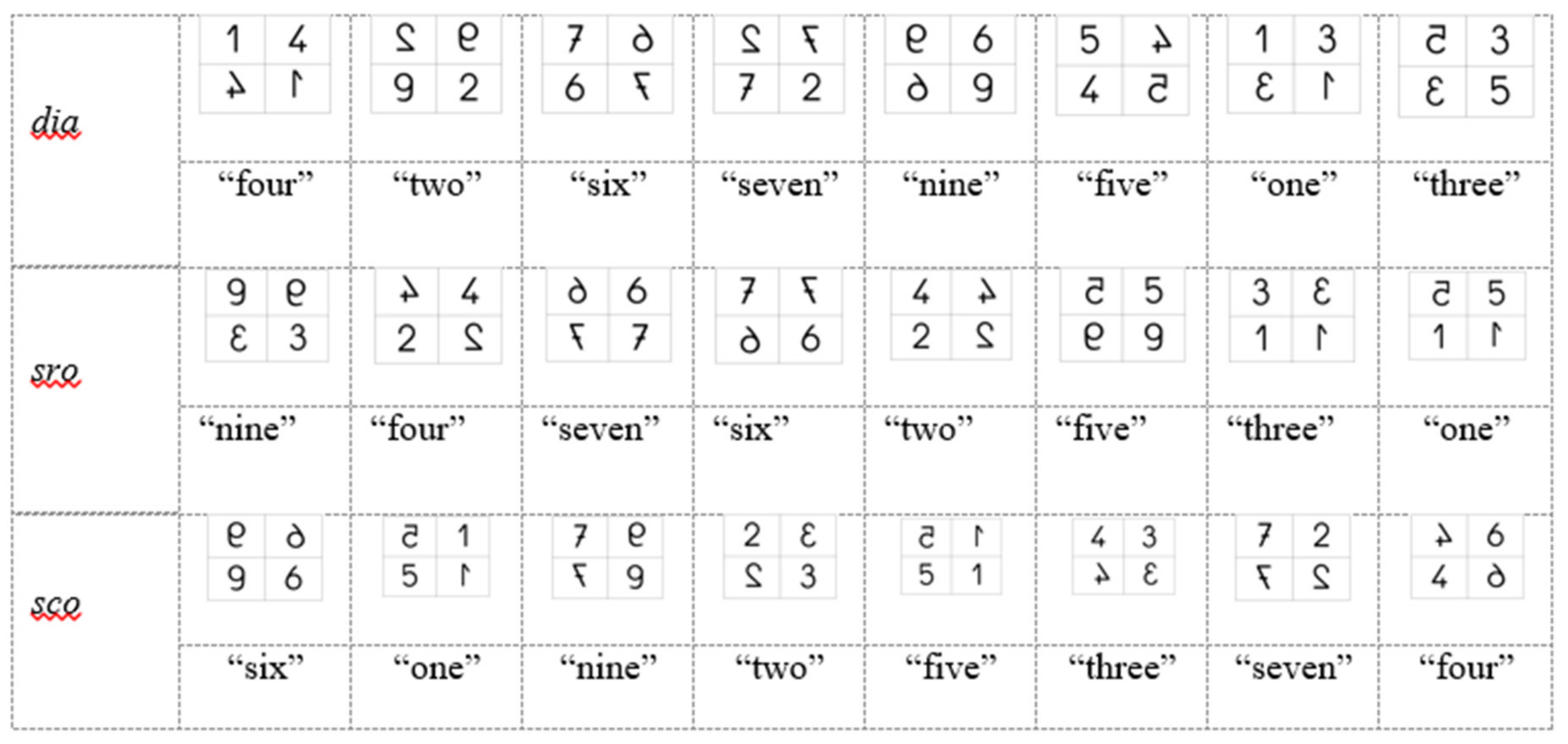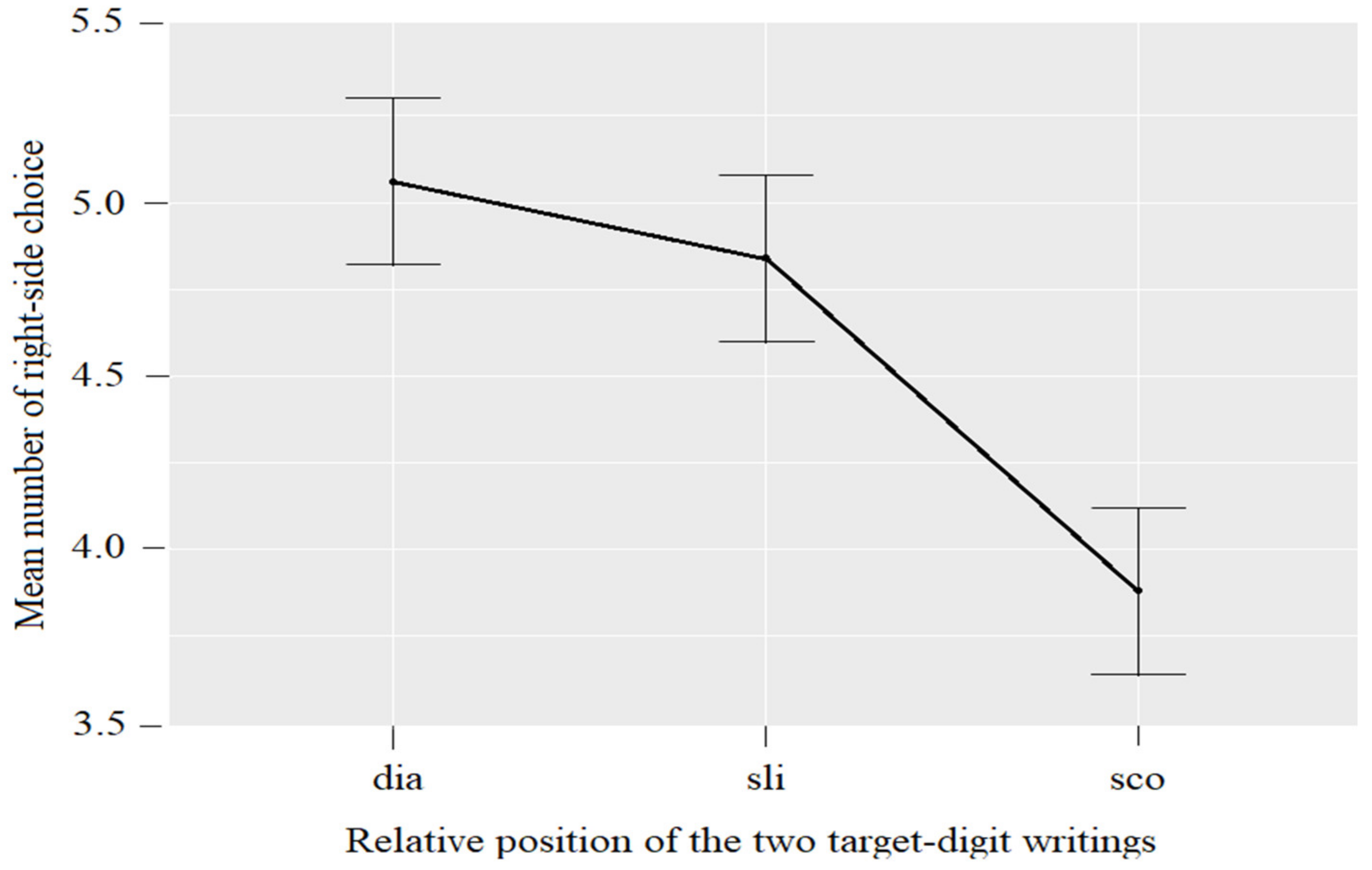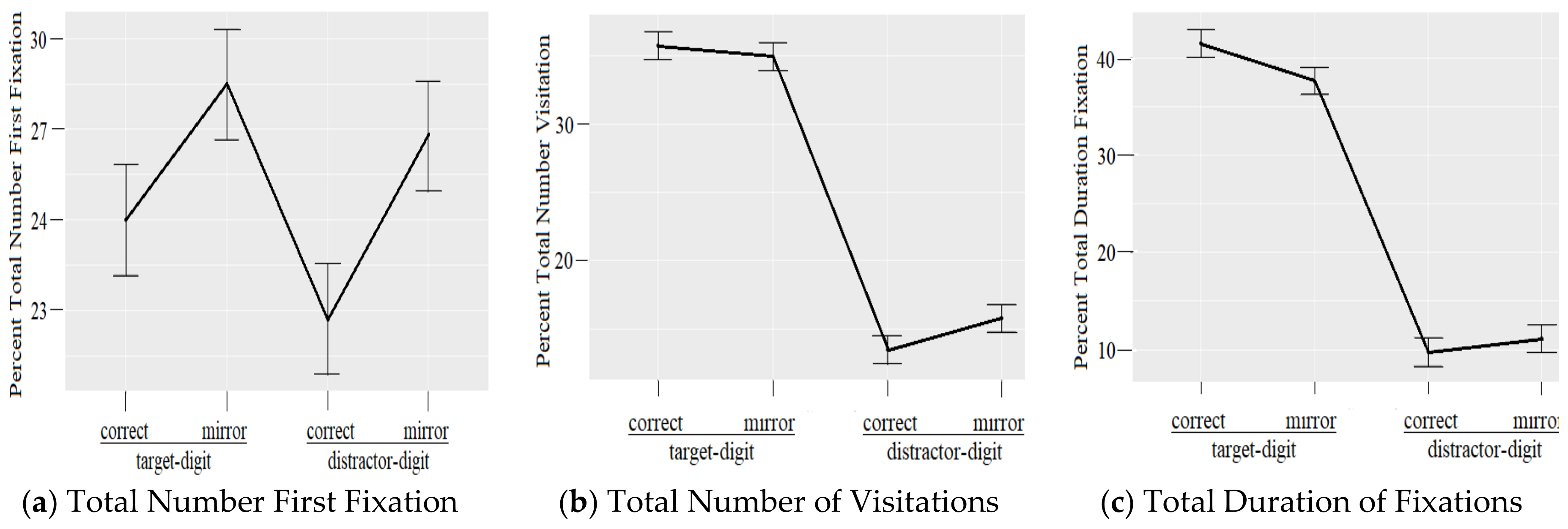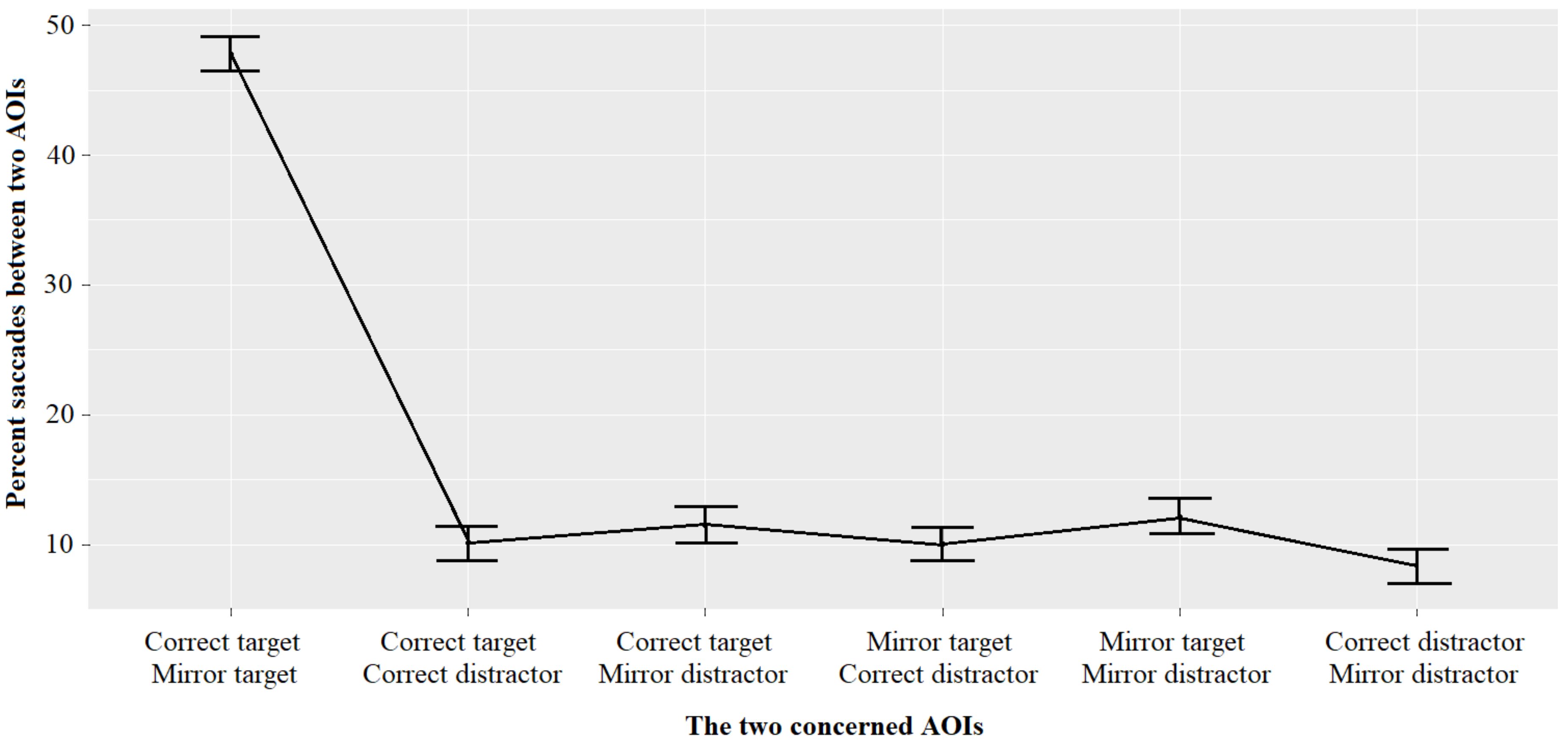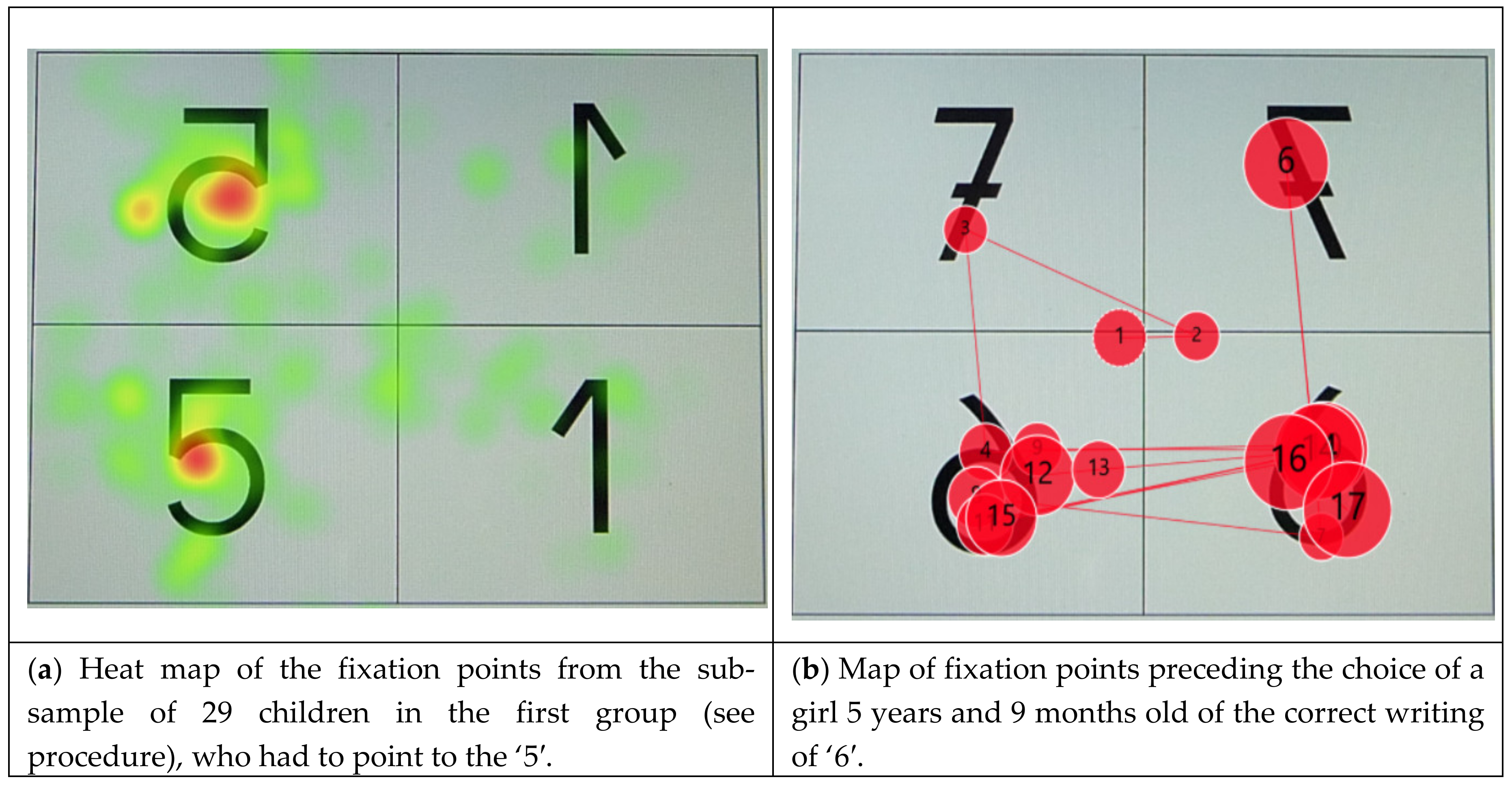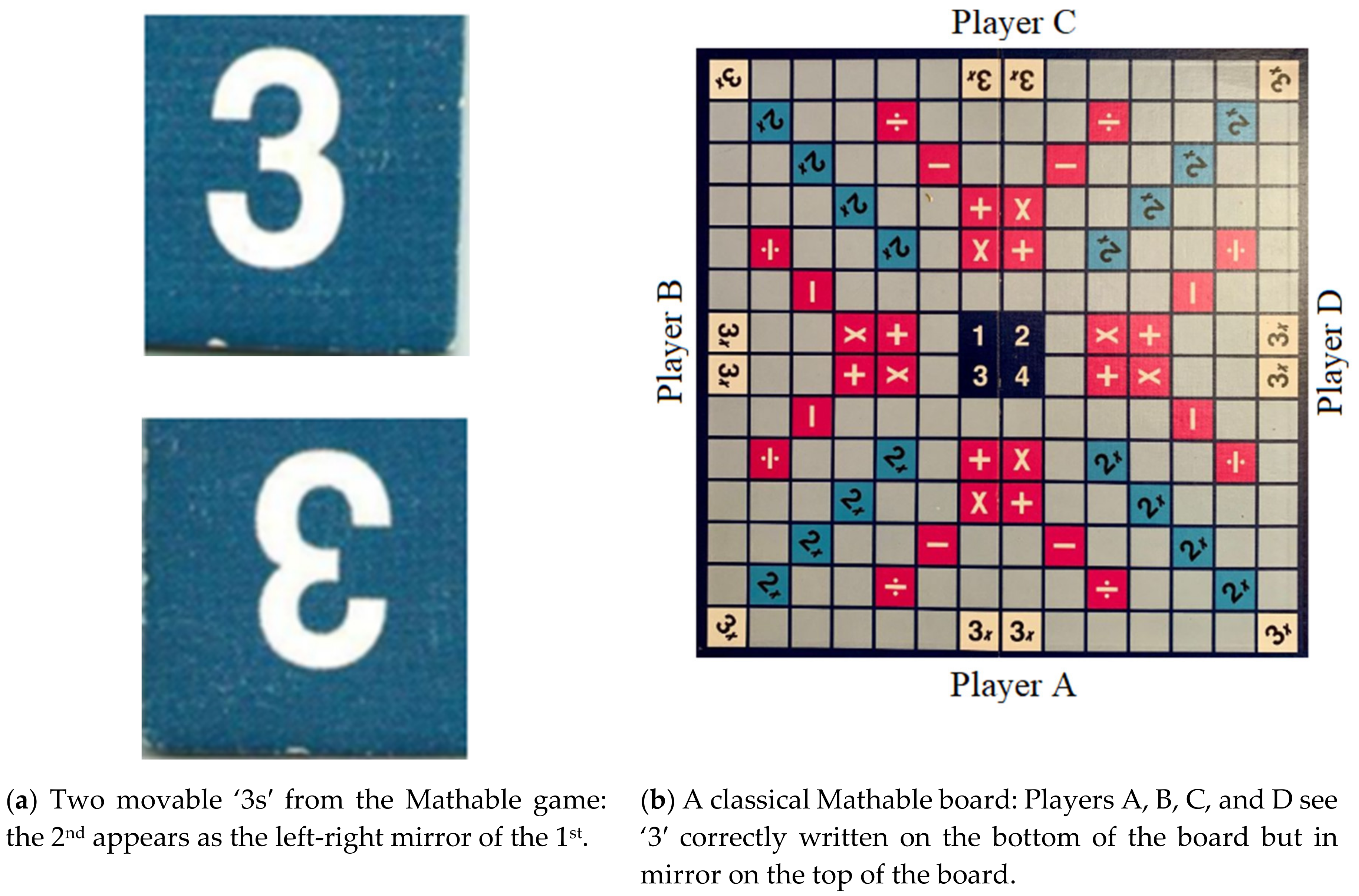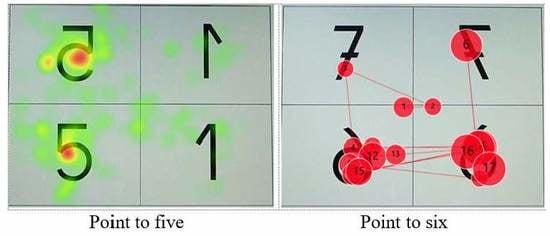1. Introduction
Since the “discovery” of mirror writing by Buchwald in 1878 [
1], the phenomenon of reversal of the characters (mainly letters, secondarily digits, for example
ε instead of
3) by 3- to 7-year-old children has generated many theoretical accounts. We will distinguish two sorts of such accounts, depending on whether the theories seek the explanation of mirror reversal in the participants or in the composition of the characters.
Theories of the first sort attribute a differential role to the two cerebral hemispheres, which can support two different representations of a character. Orton’s account on dyslexia clearly pertains to this first sort [
2]. These accounts do not clearly differentiate between the confusion of the characters in seeing them and their reversal in writing them. Orton’s theory was then mainly improved by Corballis and coworkers [
3,
4,
5]. The double representation, one writing in each hemisphere, offers a simple explanation of confusion between a character and its mirror; that is, the use of the “wrong hemisphere” [
6]. An original variant of this sort of theoretical account was suggested by Lachmann and coworkers [
7,
8,
9]. These researchers see the confusion between a character and its mirror as a specific case of the holistic processing mode in younger children which will be replaced (suppressed) by an analytical one through experience (and automatization) in reading letters or digits. The differential mode of processing often attributed to the two hemispheres—the right hemisphere excels at holistic processing of information whereas the left excels at analytic [
10]—and the typical perceptual and cognitive development going from the holistic toward the analytic mode [
11] (but see also [
12]), support this theory. Furthermore, the recent finding that adults who are the most sensitive to inversion of the words (rotation of 180° and right-to-left writing) are those who engage the right visual word form area the most [
13], reinforces the possible role of the two cerebral hemispheres in the differential use of the two modes of processing. Importantly, this first sort of theoretical account leads to mainly attributing the problem of mirror reversal confusion to some persons or populations. For example, there is a considerable literature on the confusion between characters among children [
14,
15] or adults [
16,
17] who write with their left hand, and among learning-disabled children [
14,
18].
The second sort of theoretical account was initially developed through the analysis of the form of the characters [
19,
20,
21,
22]. Thus, these theories emphasize the characters rather than the persons. The authors of these theories have noted that many Latin letters have a roughly vertical stem with an appendage to the right (B, D, E, F, K, L, N, P, and R for the asymmetrical capital letters). This particularity of the letters makes them look toward the right; that is, in the direction of writing in our culture. Thus, when writing, one may be tempted to turn all capital letters, including J and Z, toward the right. However, this is not sufficient to explain confusion between a correctly written and a mirror written character and, furthermore, does not hold for the digits that, in majority, look toward the left (1, 2, 3, 7, and 9 for the asymmetrical digits). It was the process of mirror generalization in memory [
3,
23,
24,
25,
26] that allowed us to complete the theory. Because this process results in an unoriented representation of the characters in memory, children who are asked to write a character on a sheet of paper should be in difficulty [
27]. The empirical work by Fischer and coworkers [
28] shows that a great number of these children adopt a simple, but reasonable, solution to overcome the difficulty. They merely orient the characters in the direction of writing [
29,
30]. Consequently, in writing, they reverse the left-oriented characters (J, Z, 1, 2, 3, 7, and 9). However, two interesting questions induced by this proposition remain unanswered.
First, because unoriented representations are also activated in reading or recognition tasks (see [
28], Section 5.5), a “battle” should be observed when children must make a choice between correctly or mirror-written characters. Second, if such a battle occurs, do children apply the same solution; that is, to prefer the characters oriented in the direction of writing, whether correctly or mirror written? If not, how do they base their choice of the correct writing? The observation of the possible battle in recognition memory and these questions were the main aims of the present research.
To achieve these aims, a very simple approach—asking the children to choose the correct writing when a target character is displayed beside its mirror image—was selected. If the representations of the characters are unoriented in recognition memory, the correct and mirror writings of a character will appear equally valid. This will result in considerable hesitation or even inability to correctly identify the correct writing. Presenting just these two writings simultaneously forces a child who has not overcome the problem of mirror generalization to choose between what he or she perceives as two valid writings. This problem does not disappear when the two writings are presented among other characters, but it may attenuate its apparent difficulty by enabling 4- to 5-year-old children to apply their knowledge of the characters’ shapes (without orientation) and thereby easily reject writings whose shapes are inappropriate. Consequently, we used this way of testing recognition memory. For practical reasons, most notably to facilitate the use of an eye-tracking system, we limited to four the number of writings simultaneously displayed in 2 × 2 matrices.
Another important methodological choice was the type of materials to use which, because we carried out the study in France, had to take into account the way children in France’s
écoles maternelles are taught to write the characters.
Écoles maternelles are divided into three “sections”: lower, middle, and upper. Children generally begin learning how to write in the middle section, starting with the uppercase letters and then the digits. They may be taught to write the lowercase letters when they are in the upper section, at which point teachers have to decide whether to teach printing or cursive writing. Most teachers prefer cursive writing. Consequently, uppercase letters and digits are the most appropriate material for systematic statistical studies of 4- to 5-year-old children’s knowledge of the characters. Eleven of the 26 uppercase letters are symmetrical about a vertical axis (i.e., a horizontal mirror reversal is indistinguishable from a correct writing). Of the 15 remaining asymmetrical uppercase letters, only two (J and Z) appear to be left-oriented, as reported by studies measuring adults’ ratings of the characters’ left or right orientations [
31,
32]. Conversely, most of the digits (1, 2, 3, 7, and 9) are reported as being left-oriented [
32]. Thus, digits offer a greater possibility for observing reversal errors if these errors are induced by a character’s left orientation, as suggested for writing the characters [
28].
Finally, in order to ascertain whether a battle between a correct and a reversed writing of a digit actually takes place, we used an eye-tracker. The eye-tracker allowed us to determine whether children who are trying to choose the correct writing of a target skip back and forth between the correct writing and the mirror target, and to compare the frequency of these skips of attention with other possible skips (e.g., between the correct and mirror writings of the distractor). As observed in writing, children seem to bootstrap the orientation of the digits. The active verb “bootstrap” means that they do this themselves, through improvised means, with a self-initiated process and with no apparent outside help [
33]. Therefore, the use of an eye-tracker was not only original, but also very appropriate for observing the children’s choice of the digits’ orientation.
Because experiments on recognition of written digits in competition with their mirror writing are very scarce, a consequent pilot study was however desirable. A behavioral pilot study was possible as part of a more general test of an emergent numeracy project called LINUMEN (LIttératie et NUMératie Émergentes par le Numérique: see [
34]). Hence, 169 children (
Mage = 5.07 years;
SD = 0.60; 75 girls) from 11 classes at three
écoles maternelles participating in the project were recruited. They were successively presented with eight 2 × 2 matrices containing a correct writing of the target digit and three distractor writings, one of which was the mirror reversal of the target digit. Each matrix was devoted to one of the eight asymmetrical digits. For example, in the first matrix, the target 7 was located in the second column (i.e., right part of the matrix) and row (i.e., bottom part of the matrix) and its reversal
![Education 10 00183 i001 Education 10 00183 i001]()
in the first column and row (i.e., diagonally opposite from target); the matrix was completed with the digit 3 (i.e., any other asymmetrical digit) and its reversal e. All the other seven matrices followed an analogous construction.
Two important conclusions could be drawn from this pilot study with respect to our initial purpose. First, it is unnecessary to observe a considerable number of children because the children’s choices concentrate on the target and its mirror. Indeed, an overwhelming majority of the children chose either the correct target (mean = 61.8%) or the mirror target (mean = 35.2%), with fewer than 5% of the children choosing one of the two distractors. Second, children’s choices were biased toward the right side of the matrix. We found a preference for responses in the right side column, with children choosing writings from the right side column in 60% of the trials and from the left side column in 40% of the trials. A paired participant’s t-test showed this difference to be highly significant, t(168) = 6.682, p < 0.001, η2 = 0.210. These findings fundamentally explain the rationale of our following experimental design.
3. Discussion
3.1. The “Battle” between Correct and Reversed Writings of Digits in Children’s Recognition Memory
The behavioral results first showed that the children chose, as expected, the correct (60.1%) or mirror (38.3%) targets much more frequently than they chose the correct (0.8%) or mirror (0.8%) distractors. The eye-tracking data confirmed that the percentages of visitations and durations of fixations were higher (and approximately equal) for the AOIs containing the correct and mirror targets than they were for the AOIs containing the correct and mirror distractors.
Eye movements showed a systematic relationship between the digit heard and where the eyes tended to go in the 2 × 2 matrix. After initially landing on one of the matrix’s four cells, the children’s gaze moved back and forth, mainly between the cells containing the correct and mirror targets. Despite the presence of the other two distractors, the children’s resulting choices were then essentially restricted to the two writings of the target digit.
Can these results not simply be explained by perceptual similarity? For example, 5 and its mirror are surely, additionally of their transformational relation, more similar to each other than 5 and 1 in terms of Gestalt (e.g., structure, complexity). However, 1 and its mirror also are more similar to each other than 1 and 5. Therefore, the perceptual similarity cannot explain why the children focused on 5 and its mirror, when 5 is the requested target, and on 1 and its mirror when 1 is the requested target. A simple physical similarity between a target and its mirror cannot account for the concentration on these two writings: children must use their memorized knowledge of the form of the requested digit. In fact, the similarity, or even the identity of a target digit and its mirror is a direct consequence of the unoriented representation.
The distribution of choices concentrates on the writings of the target digits; the distractor digits (other than the reversed target digit) accounting for less than 1% of the children’s choices. Such a distribution could also occur if there was a binary division between two populations of children, with a majority population of children who know the correct writing and a minority population of children who have a mirror representation of the target. However, the predominance of saccades between the correct and mirror targets suggest that the true explanation for this distribution is a genuine battle in the children’s recognition memory between the two orientations of the target digit (Hypothesis 1). Spontaneous comments by some very few children provided incidental evidence corroborating the hesitation or embarrassment accompanying their choice between the two target writings. For example, when a 4-year, 10-month-old boy was shown the final matrix in the
sco condition (see
Figure 1) and instructed to point to “four”, he, somewhat vexedly, said: “They are all the same”. The systematic analysis of the saccades between the AOIs as the children made their choice clearly confirmed our battle hypothesis.
Many visual images provided by the eye-tracking system illustrate this battle between the two writings in the children’s recognition memory (see
Figure 5). To our knowledge, this curious battle has never been demonstrated, despite the huge body of research conducted during the 142 years since Buchwald first introduced the notion of “mirror writing” [
1].
The present results therefore support the theoretical account of character reversals in typical 4- to 6-year-old children, most notably the idea that representations of the digits in the memory of a great number of children are unoriented, at least at a certain stage of their development (see Introduction). They support both the theory as a whole and its individual components. Thus, both the neurological component—the process of mirror generalization—and the developmental component—which assumes that 4- to 6-year-old children know the shapes of the digits without orientation—are supported by our findings. The latter is specifically supported by the fact that our participants rarely confused the writings of the target digit with the writings of another digit and often confused the two writings of the target digit.
3.2. The Right Spatial Position Versus Digit’s Orientation Bias in the Children’s Recognition Response-Choices
The right spatial position bias was revealed incidentally in the pilot study and was confirmed by our present experience when the two writings of the target digit were not in the same column. Importantly, children who pointed with their left hand also showed the bias, making unlikely a simple biomechanical advantage toward the dominant-hand side of space. In addition, the three conditions included in this experiment allowed us to establish a consequence of the implicit right spatial position bias: when this choice is impossible, it may be replaced by another spatial bias, this time for the upper half of the matrix.
Mixed logistic regression modeling showed the right spatial position of the digits to be the main factor influencing choices of the mirror target. The influence of other individual factors was either insignificant, in the case of pointing hand and age (within the restricted age range of our participants), or ambiguous, in the case of gender. It also suggests that the left-right orientation of the digits, which appears to be a major explanation for their reversal in a left-right writing culture [
28,
29,
30], plays only a minor role when children are prompted to choose between a digit and its mirror, differentiated by their left or right horizontal position. These results are in accord with the confirmation of our right-side response hypothesis (Hypothesis 3) at the expense of the digit orientation hypothesis (Hypothesis 2).
The right-side preference is consistent with the visual-spatial biases frequently reported in preschool children [
38]. We suggest that it may be a direct result of the writing/reading direction in our culture, although a rightward directional bias was recently reported in art produced by cultures without a written language [
39]. It was shown that writing/reading direction can affect many thoughts and actions [
40], and an overall dominance of the left-to-right counting direction in 3- to 5-year-old children in a Western culture (Germany) was reported [
41]. Moreover, this counting direction may be influenced by children observing the direction in which storybooks are read to them [
42]. In addition, preliterate children may learn the direction of text when learning to write (notably their name) at
école maternelle, in exercise books, and/or with their parents.
A right spatial bias in typical developing children was also attributed to a selective attention deficit [
43]. For example, in a line bisection task, a rightward bias in attention diminishes the apparent leftward extent of the line and, thus, leads to a response at the right of the true half. This was effectively found in right-handed children (5-7 years) when they responded with the right hand [
44]. Because the attentional system was clearly challenged in our experiments, the right-side choice could result from such attentional bias. Interestingly, Lange-Küttner suggests “that a right spatial bias lingers throughout the life-span and may reemerge” [
43] (
p. 844), particularly under performance pressure or, as was the case in our experiment, when a child hesitates and has no other means to choose the side of its response.
Can the Spatial-Numerical Association of Response Codes (SNARC) effect [
45] contribute to explain this right-side preference? The SNARC effect was originally found in tasks in which magnitude (or parity, another numerical property) was assessed using a response-time measure. It describes the tendency for people presented with a mix of larger and smaller numbers to respond faster with the right hand for the larger numbers and to respond faster with the left hand for the smaller numbers (in a left-to-right reading culture). The tasks used in our experiments involved only the visual properties of the digits (not their magnitude), and we assessed just the accuracy (but not the speed) of digit recognition. However, the numerical line showing the order of the digits from 0 to 10 (and sometimes beyond) that is displayed in all classrooms, even in
écoles maternelles, may act as a powerful source of magnitude information [
46]. In addition, magnitude may be activated automatically, even in young children [
47]. Given the generality of the SNARC effect, which has been extended to other tasks and stimuli (e.g., pitch: see [
48]), and to preschoolers [
47], a SNARC-like effect must be considered a possible explanation for our right-half preference finding. However, both in our pilot study and experiment (see
Figure 1), half of the larger target digits (5, 6, 7, and 9) were displayed in the left-side column and the other half were displayed in the right-side column. This was also the case for the smaller digits (1, 2, 3, and 4). Now consider a theoretical child who hesitates between the two writings of the target digit and chooses responses in the right-side column for the larger digits and responses in the left-side column for the smaller digits. For the 24 matrices in
Figure 1 this child would produce exactly the same number of right-side-column choices as left-side-column choices (12 of each). Therefore, the right-side preference revealed by our experiments is unlikely to be due to a SNARC-like effect.
Does other research confirm the right-side bias at the expense of choice based on a digit’s orientation in character recognition? To the best of our knowledge, there are only two studies to have examined in a single group of children the relation between left-right reversing when writing characters and falsely recognizing mirror reversed characters [
49,
50]. Both studies found the two phenomena to be similar. Because they also found the left-oriented characters—the letters j and z, and the digits 3, 7, and 9—to be more prone to reversal, they are at odds with the results of our experiment. Indeed, the reversed left-oriented digits were not chosen significantly more frequently than the reversed right-oriented digits, contrary to the prediction of Hypothesis 2. However, our experiment provides an explanation for this divergence in the form of a spatial position bias in the children’s recognition responses. This is a major, and perhaps sufficient explanation, for the divergence between these findings and our results. Neither the correct letter and word reading task used in the first study [
49], nor the letter decision task used in the second [
50] allowed a spatial choice.
3.3. Educational Implications
In reading normal arithmetic writings, a digit is rarely simultaneous seen with its left-right mirror reversed writing. An exception may come from the symmetrical (around a horizontal axis) digit 3 when children play—or see others play—with movable digits in cardboard, plastic, or wood. They can then simultaneously see two ‘3s′, one that appears the correctly written 3 and the other written ε, as shown in
Figure 6a. This is the case in the Mathable game—a mathematical/numerical version of the better known Scrabble game of words. The problem of the veracity of a mirror written 3 is also exacerbated with a classical presentation of the Mathable board, as shown in
Figure 6b. More generally, with the 52 classical playing cards, children can see simultaneously the two writings of the digit ‘3′, but not two left-right reversed writings for the other asymmetrical digits, because their two writings are obtained from each other through a 180° rotation (and not through a left-right symmetry). Drawing the attention of a child who is playing, or simply observing the game, to the two writings of 3 seems to be an elementary educational act. Nevertheless, when a child is at the stage of unoriented representation of digits, this act is fundamental. Of course, it will be accompanied by an emphasis on the validity of only one of the two writings, namely “3”, in our culture, especially at school.
However, in supporting the theory of an unoriented representation of the characters in memory, our results also concern writing of the digits. Moreover, it is highly probable that our demonstration extends to characters other than digits, notably lowercase letters. This extension, for example, accounts for the finding that 1st, 3rd, and 5th graders require more time to discriminate between two lowercase letters that are lateral mirror images of one another (e.g., b and d) than two lowercase letters that are not (e.g., f and t) [
51]. It leads to emphasis on the confusion in reading between b and its mirror reversal d, because these are the most common letters that are reversed.
Parents are worried about this confusion as shown by their numerous thanks for tips and tricks helping their children correct b/d reversals, which one can find on the internet (e.g., multisensory activities, air writing, the “bed” visualization, …: see, for example,
https://www.readandspell.com/b-and-d-letter-reversal). One wonders whether these tricks can be proved effective. According to Fischer and Tazouti, the effectiveness of many tools or techniques used by teachers for teaching writing of the digits are supported by their data [
52]. However, there is less evidence for the effectiveness of these tricks. Therefore, it is worthwhile to note that a trick used by the French children for the writing of the uppercase letter N is so effective that N proved be the least reversed capital letter [
28]. This trick is to notice that to trace the letter N one must “go up, go down, and finally go back up” while writing from left to right. This quasi-absence of reversals affecting the writing of the letter N is particularly impressive when one recalls Goodnow and Levine’s prediction that children might well “grow into reversals of the letter N as they acquire the rules of starting at the top-left, starting with a vertical stroke, and threading” [
53] (p. 96).
Primary teachers should be informed that students have generally no difficulty in differentiating visually b and d, or p and q, but that all of them must initiate and consolidate their differentiation in memory and, most importantly, that some students struggle with this differentiation. This would allow teachers to take preventive actions (such as the above tricks) that would reduce the risk of embarrassment in these children and, ultimately, the resulting risk of loss of their self-esteem. Indeed, letter reversals are particularly noticeable errors and fear of making them may not only disrupt fluency in writing but also interfere with a child’s ability to express him or herself.
3.4. Limitations of the Study
Our study’s main limitation concerns the possibility of generalizing the results, most notably because each target digit did not appear equally frequently at each matrix position. We also have not taken into account factors such as visual similarity (e.g., 6–9, 7–1) and numerical magnitude (e.g., 6–7). However, the results of the pilot study (succinctly reported in the Introduction) argue against a significant biasing impact of these limitations. This is because we obtained similar results with different material in the pilot study than in the eye-tracking experiment. Nevertheless, while this study has investigated the impact of the digits’ orientation and of their place in the 2 × 2 matrix, further studies should control the possible influence of other factors that might affect the selection of the target item, such as visual similarity (6–9) or numerical magnitude (6–7).
In addition, our clear and significant results were all obtained with a recognition test involving a visual search in a 2 × 2 matrix in which the three distractors were a mirror writing of the target digit and two writings of another digit. Although we created three conditions and randomized (with some constraints) the positions of the distractors and the order in which we presented the matrices in our experiment, many other stimuli and procedures could have been used. Using an eye-tracking system does not preclude displaying two items [
54], three items [
55], or even five or more items. Thus, further studies are needed to ensure our findings concern recognition in general and are not specific to the format of our stimuli.
Another limitation arises from the eye-tracker system we used which, even with the latest version of the associated software [
35], did not have the capabilities needed to examine the time course of the preferential viewing effect. Using a more sophisticated eye-tracking system would have enabled us to examine the children’s fixations at specific times, most notably the period immediately before they give their answers. This would allow a more detailed analysis of the response intention effect [
56]; that is, the natural tendency to look at the writing that is about to be selected [
55].
4. Conclusions
The 4- to 6-year-old participants in our experiment heard an auditory input corresponding to a target digit contained in one of the cells of a 2 × 2 matrix displayed in front of them. The other three cells contained distractors, one of which was a mirror-written version of the target digit.
The experiment provides evidence for a battle between correct and reversed writings which ensues when children are required to choose the correct writing in a display containing both correct and mirror writings of a digit. It is also, as far as we are aware, the first demonstration that the right-orienting rule explaining children’s character reversals in writing does not influence the visual recognition of these characters. More generally, the research supports the claim that a substantial number of 4- to 6-year-old children have unoriented representations of the writing of the digits in their memory.
When forced to choose between the correct and mirror writings of a digit, children’s choices are influenced by a right-side preference. However, if this right-side preference cannot come into play, as is the case when both writings are on the same side, children may resort to a vertical preference and choose the upper writing. This latter preference is less systematic. Importantly, these visual-spatial biases seem to minimize, or even exclude, choices based on whether the digit is left-oriented or right-oriented. When writing, Fischer and Luxembourger’s explanation of mirror reversals as arising from the left-orientation of the digits is very different [
28].
Therefore the present findings challenge the accepted way of thinking that character reversal (digits and letters) by typical developing children is the same phenomenon in reading and writing. None of the numerous studies on reversal in reading [
7,
51,
57,
58,
59,
60,
61,
62,
63,
64] underlines such a difference between the two tasks, which are associated in teaching/learning and in the brain [
65]. Nevertheless, a simple description of the behavior of children who have unoriented representations of digits can account for the difference between writing and reading: when writing, children make the digits face right and therefore reverse the left-oriented digits 1, 2, 3, 7, and 9; when choosing between a correct and a mirror writing in a recognition task, (if possible) they choose the writing on the right.
 in the first column and row (i.e., diagonally opposite from target); the matrix was completed with the digit 3 (i.e., any other asymmetrical digit) and its reversal e. All the other seven matrices followed an analogous construction.
in the first column and row (i.e., diagonally opposite from target); the matrix was completed with the digit 3 (i.e., any other asymmetrical digit) and its reversal e. All the other seven matrices followed an analogous construction. respectively. Note that the debatable right-oriented categorization of digit 4 was well argued in other studies [28,33].
respectively. Note that the debatable right-oriented categorization of digit 4 was well argued in other studies [28,33].